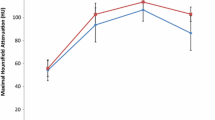Abstract
Purpose
To investigate if multiphasic multidetector computed tomography (MDCT) enhancement profiles can distinguish clear cell renal cell carcinomas (ccRCCs) with high carbonic anhydrase-IX (CA-IX) expression from ccRCCs with low CA-IX expression.
Methods
With IRB approval for this retrospective study, we derived a cohort of 105 histologically proven ccRCCs with preoperative 4-phase renal mass MDCT from 2001 to 2013. Following manual segmentation, the computer-assisted detection algorithm selected a 0.5-cm-diameter region of maximal attenuation within each lesion in each phase. CA-IX expression level was determined by immunohistochemical staining of tumor specimens. In the high and low CA-IX expression subgroups, the magnitude of enhancement and washout were compared using t tests; the performance of contrast washout in differentiating between subgroups was assessed with logistic regression analysis.
Results
ccRCCs with high and low CA-IX expression both exhibited peak enhancement in the corticomedullary phase. ccRCCs with high CA-IX expression demonstrated significantly greater relative nephrographic washout than those with low CA-IX expression (18.4% vs. 7.8%, p = 0.03). ccRCCs with high CA-IX expression had greater relative excretory washout than ccRCCs with low CA-IX expression with a trend toward significance (33.4% vs. 25.2%, p = 0.05). After controlling for tumor size and stage, for distinguishing ccRCCs with high and low CA-IX expression, relative excretory washout had a sensitivity, negative predictive value, accuracy, and positive predictive value of 99% (65/66), 88% (7/8), 69% (72/105), and 67% (65/97), respectively.
Conclusion
Relative nephrographic and excretory washout may have the potential to help distinguish ccRCCs with high and low CA-IX expression, but this requires further validation.




Similar content being viewed by others

References
Gore ME, Larkin JM (2011) Challenges and opportunities for converting renal cell carcinoma into a chronic disease with targeted therapies. Br J Cancer 104(3):399–406. https://doi.org/10.1038/sj.bjc.6606084
Kovacs G, Akhtar M, Beckwith BJ, et al. (1997) The Heidelberg classification of renal cell tumours. J Pathol 183(2):131–133. 10.1002/(sici)1096-9896(199710)183:2<131::aid-path931>3.0.co;2-g
Truong LD, Shen SS (2011) Immunohistochemical diagnosis of renal neoplasms. Arch Pathol Lab Med 135(1):92–109. https://doi.org/10.1043/2010-0478-rar.1
Cheville JC, Lohse CM, Zincke H, Weaver AL, Blute ML (2003) Comparisons of outcome and prognostic features among histologic subtypes of renal cell carcinoma. Am J Surg Pathol 27(5):612–624
Hoffmann NE, Gillett MD, Cheville JC, et al. (2008) Differences in organ system of distant metastasis by renal cell carcinoma subtype. J Urol 179(2):474–477. https://doi.org/10.1016/j.juro.2007.09.036
Amin MB, Corless CL, Renshaw AA, et al. (1997) Papillary (chromophil) renal cell carcinoma: histomorphologic characteristics and evaluation of conventional pathologic prognostic parameters in 62 cases. Am J Surg Pathol 21(6):621–635
Beck SD, Patel MI, Snyder ME, et al. (2004) Effect of papillary and chromophobe cell type on disease-free survival after nephrectomy for renal cell carcinoma. Ann Surg Oncol 11(1):71–77
Moch H, Gasser T, Amin MB, et al. (2000) Prognostic utility of the recently recommended histologic classification and revised TNM staging system of renal cell carcinoma: a Swiss experience with 588 tumors. Cancer 89(3):604–614
Stillebroer AB, Mulders PF, Boerman OC, Oyen WJ, Oosterwijk E (2010) Carbonic anhydrase IX in renal cell carcinoma: implications for prognosis, diagnosis, and therapy. Eur Urol 58(1):75–83. https://doi.org/10.1016/j.eururo.2010.03.015
Bui MH, Seligson D, Han KR, et al. (2003) Carbonic anhydrase IX is an independent predictor of survival in advanced renal clear cell carcinoma: implications for prognosis and therapy. Clin Cancer Res 9(2):802–811
Lam JS, Pantuck AJ, Belldegrun AS, Figlin RA (2007) Protein expression profiles in renal cell carcinoma: staging, prognosis, and patient selection for clinical trials. Clin Cancer Res 13(2 Pt 2):703s–708s. https://doi.org/10.1158/1078-0432.ccr-06-1864
Young JR, Margolis D, Sauk S, et al. (2013) Clear cell renal cell carcinoma: discrimination from other renal cell carcinoma subtypes and oncocytoma at multiphasic multidetector CT. Radiology 267(2):444–453. https://doi.org/10.1148/radiol.13112617
Lee-Felker SA, Felker ER, Tan N, et al. (2014) Qualitative and quantitative MDCT features for differentiating clear cell renal cell carcinoma from other solid renal cortical masses. AJR Am J Roentgenol 203(5):W516–524. https://doi.org/10.2214/ajr.14.12460
Coy H, Young JR, Douek ML, et al. (2017) Quantitative computer-aided diagnostic algorithm for automated detection of peak lesion attenuation in differentiating clear cell from papillary and chromophobe renal cell carcinoma, oncocytoma, and fat-poor angiomyolipoma on multiphasic multidetector computed tomography. Abdom Radiol (NY) 42(7):1919–1928. https://doi.org/10.1007/s00261-017-1095-6
Zhang J, Lefkowitz RA, Ishill NM, et al. (2007) Solid renal cortical tumors: differentiation with CT. Radiology 244(2):494–504. https://doi.org/10.1148/radiol.2442060927
Kim JK, Kim TK, Ahn HJ, et al. (2002) Differentiation of subtypes of renal cell carcinoma on helical CT scans. AJR Am J Roentgenol 178(6):1499–1506. https://doi.org/10.2214/ajr.178.6.1781499
Sheir KZ, El-Azab M, Mosbah A, El-Baz M, Shaaban AA (2005) Differentiation of renal cell carcinoma subtypes by multislice computerized tomography. J Urol 174 (2):451–455; discussion 455. https://doi.org/10.1097/01.ju.0000165341.08396.a9
Jinzaki M, Tanimoto A, Mukai M, et al. (2000) Double-phase helical CT of small renal parenchymal neoplasms: correlation with pathologic findings and tumor angiogenesis. J Comput Assist Tomogr 24(6):835–842
Ruppert-Kohlmayr AJ, Uggowitzer M, Meissnitzer T, Ruppert G (2004) Differentiation of renal clear cell carcinoma and renal papillary carcinoma using quantitative CT enhancement parameters. AJR Am J Roentgenol 183(5):1387–1391. https://doi.org/10.2214/ajr.183.5.1831387
Rosenkrantz AB, Matza BW, Portnoy E, et al. (2014) Impact of size of region-of-interest on differentiation of renal cell carcinoma and renal cysts on multi-phase CT: preliminary findings. Eur J Radiol 83(2):239–244. https://doi.org/10.1016/j.ejrad.2013.10.020
Young JR, Coy H, Douek M, et al. (2017) Type 1 papillary renal cell carcinoma: differentiation from Type 2 papillary RCC on multiphasic MDCT. Abdom Radiol (NY) 42(7):1911–1918. https://doi.org/10.1007/s00261-017-1091-x
Young JR, Coy H, Douek M, et al. (2017) Clear cell renal cell carcinoma: identifying the gain of chromosome 12 on multiphasic MDCT. Abdom Radiol (NY) 42(1):236–241. https://doi.org/10.1007/s00261-016-0868-7
Young JR, Coy H, Kim HJ, et al. (2017) Performance of relative enhancement on multiphasic MRI for the differentiation of clear cell renal cell carcinoma (RCC) from papillary and chromophobe RCC subtypes and oncocytoma. AJR Am J Roentgenol 208(4):812–819. https://doi.org/10.2214/ajr.16.17152
Young JR, Margolis D, Sauk S, et al. (2014) Clear cell renal cell carcinoma: multiphasic MDCT enhancement can predict the loss of chromosome 8p. Abdom Imaging 39(3):543–549. https://doi.org/10.1007/s00261-014-0092-2
Young JR, Young JA, Margolis DJ, et al. (2016) Clear cell renal cell carcinoma: identifying the gain of chromosome 20 on multiphasic MDCT. Abdom Radiol (NY) 41(11):2175–2181. https://doi.org/10.1007/s00261-016-0813-9
Sedlakova O, Svastova E, Takacova M, et al. (2014) Carbonic anhydrase IX, a hypoxia-induced catalytic component of the pH regulating machinery in tumors. Front Physiol 4:400. https://doi.org/10.3389/fphys.2013.00400
Acknowledgments
This study was funded by the Society of Abdominal Radiology Howard S. Stern Research Grant (Grant No. 20163335). We thank the UCLA Computer Vision and Imaging Biomarker (CVIB) group, including Dr. Jonathan Goldin, Dr. Matthew Brown, Moe Moe Ko, and War War Ko, for their assistance with this study.
Author information
Authors and Affiliations
Corresponding author
Ethics declarations
Conflict of interest
The authors declare that they have no conflicts of interest.
Ethical approval
All procedures performed in studies involving human participants were in accordance with the ethical standards of the institutional and/or national research committee and with the 1964 Helsinki declaration and its later amendments or comparable ethical standards.
Informed consent
The Institutional Review Board waived the requirement of informed consent for this study.
Rights and permissions
About this article
Cite this article
Young, J.R., Coy, H., Kim, H.J. et al. Utility of multiphasic multidetector computed tomography in discriminating between clear cell renal cell carcinomas with high and low carbonic anhydrase-IX expression. Abdom Radiol 43, 2734–2742 (2018). https://doi.org/10.1007/s00261-018-1546-8
Published:
Issue Date:
DOI: https://doi.org/10.1007/s00261-018-1546-8



